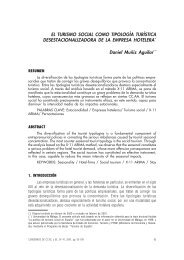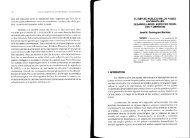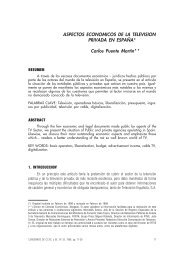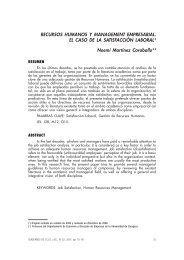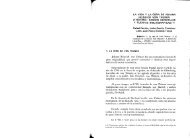Modelo Matricial de Determinación de Costes.
Modelo Matricial de Determinación de Costes.
Modelo Matricial de Determinación de Costes.
Create successful ePaper yourself
Turn your PDF publications into a flip-book with our unique Google optimized e-Paper software.
M. TERESA URGELL CHAO<br />
CUADERNOS DE CC.EE. y EE., Nº 58, 2010, pp. 53-82<br />
MODELO MATRICIAL DE DETERMINACIÓN DE COSTES<br />
la cuantía <strong>de</strong> factor semifi jo que correspon<strong>de</strong> a cada uno <strong>de</strong> ellos. Por ejemplo,<br />
suponiendo que existe un factor semifi jo (k) que <strong>de</strong>pen<strong>de</strong> directamente <strong>de</strong>l tiempo<br />
total <strong>de</strong> funcionamiento <strong>de</strong>l primer lugar <strong>de</strong> trabajo, la cantidad que tomará dicho<br />
factor localizado en el lugar 1, se obtendrá a través <strong>de</strong> la siguiente fórmula condicional<br />
<strong>de</strong> Excel:<br />
(SI(TT >I ;Q f ; SI(TT >I ;Q f ;SI(TT >I ;Q f ; Q f ))<br />
1 3 F 1k(4) 1 2 F 1k(3) 1 1 F 1k(2) F 1k(1)<br />
don<strong>de</strong>:<br />
TT = Tiempo total <strong>de</strong>l lugar 1.<br />
1<br />
I = Tiempo total máximo <strong>de</strong>l primer intervalo, siendo I = Tiempo total máximo<br />
1 r<br />
<strong>de</strong>l intervalo r.<br />
Q f = cuantía total <strong>de</strong>l factor semifi jo k localizado en el lugar 1 correspon-<br />
F 1k(1)<br />
diente al intervalo 1.<br />
En la fórmula anterior, si el tiempo total <strong>de</strong>l lugar 1(TT ) es mayor que el<br />
1<br />
tiempo máximo que correspon<strong>de</strong> al tercer intervalo (I ), la cuantía que correspon-<br />
3<br />
<strong>de</strong>rá al factor semifi jo k localizado en el lugar 1 será Q f En caso <strong>de</strong> que TT F 1k(4). 1<br />
sea menor o igual que I y mayor que I la cantidad <strong>de</strong> dicho factor será Q f 3 2 F 1k(3).<br />
Siguiendo el mismo razonamiento se llegaría a la conclusión <strong>de</strong> que la cuantía<br />
mínima que pue<strong>de</strong> tomar el factor semifi jo k es Q f . F 1k(1)<br />
Las cantida<strong>de</strong>s <strong>de</strong> costes semifi jos se pue<strong>de</strong>n representar a través <strong>de</strong> la matriz<br />
MQ f en la que existe una columna para cada factor y una fi la para cada lugar.<br />
F lk<br />
Dicha matriz, suponiendo la existencia <strong>de</strong> k factores semifi jos y <strong>de</strong> dos intervalos<br />
-(r) y (r+1)-, quedará formulada <strong>de</strong> la siguiente manera:<br />
MQ f = F lk<br />
(SI(TT1>Ir;QFf11(r+1); QFf11(r)) (SI(TT1>Ir;QFf12(r+1); QFf12(r))... (SI(TT1>Ir;QFf1k(r+1); QFf1k(r))<br />
(SI(TT2>Ir;QFf21(r+1); QFf21(r)) (SI(TT2>Ir;QFf22(r+1); QFf22(r))... (SI(TT2>Ir;QFf2k(r+1); QFf2k(r))<br />
. .<br />
. .<br />
(SI(TT l >Ir;QFfl1(r+1); QFfl1(r)) (SI(TT l >Ir;QFfl2(r+1); QFfl2(r)) ... (SI(TT l >Ir;QFflk(r+1); QFflk(r))<br />
don<strong>de</strong>:<br />
Q F f lk(r) = cuantía total <strong>de</strong>l factor semifi jo k localizado en el lugar l correspondiente<br />
al intervalo r, pudiéndose <strong>de</strong>fi nir distintos intervalos para cada factor y lugar.<br />
[9]<br />
9<br />
61



